Glycolisis
1/39
There's no tags or description
Looks like no tags are added yet.
Name | Mastery | Learn | Test | Matching | Spaced |
|---|
No study sessions yet.
40 Terms
Step 1: Glucose → Glucose-6-Phosphate
What happens? The glucose molecule enters the cell and gets hit with a phosphate from ATP.
Why? This traps glucose inside the cell and makes it chemically unstable.
Energy? 1 ATP is used here.
Visual: You’ll see ATP dropping a P onto glucose.
Analogy: Like scanning a movie ticket before you enter — once you're in, you can't leave (glucose can’t leave now).
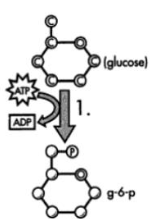
Step 2: Glucose-6-Phosphate → Fructose-6-Phosphate
What happens? The glucose gets rearranged into a new sugar form (fructose).
Why? Prepping it for another phosphate to make it symmetrical (for splitting).
Energy? None used here.
Visual: The shape of the molecule changes.
Analogy: Like twisting a Rubik’s cube to line up colors before the next move.
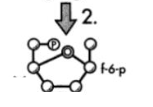
Step 3: Fructose-6-Phosphate → Fructose-1,6-Bisphosphate
What happens? Another phosphate is added from a second ATP.
Why? This makes the molecule even more unstable and ready to split.
Energy? 1 more ATP is used.
Visual: Now the sugar has 2 phosphates attached (one on each end).
Analogy: Like pulling both ends of a stick until it snaps.
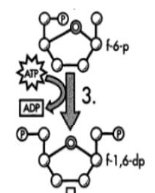
Step 4: Fructose-1,6-Bisphosphate → DHAP + G3P
What happens? The 6-carbon sugar splits in half into two 3-carbon sugars.
Why? You can’t use glucose’s energy until it's in small chunks.
Visual: You’ll see one big molecule become two.
Analogy: Like cutting a sub sandwich in half to share.
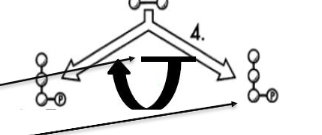
Step 5: DHAP → G3P
What happens? DHAP is converted into another G3P.
Why? So now you have two identical 3-carbon sugars to work with.
Visual: You now have 2 G3Ps going through the rest of glycolysis.
Analogy: Like converting Canadian dollars to US dollars so everything matches.
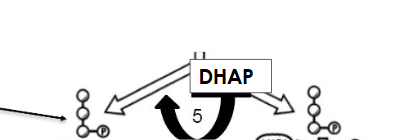
Step 6: G3P → 1,3-Bisphosphoglycerate
What happens? NAD+ takes electrons and becomes NADH; phosphate is added to G3P.
Why? This stores energy in NADH and adds energy to the sugar.
Energy? NAD+ becomes NADH for each G3P (2 total).
Visual: You’ll see electrons transferring and new P's being added.
Analogy: Like charging up a power bank (NAD+ becomes NADH).
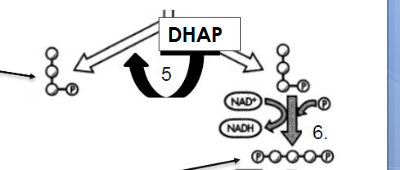
Step 7: 1,3-Bisphosphoglycerate → 3-Phosphoglycerate
What happens? A phosphate is removed and added to ADP to make ATP.
Why? First ATP payoff.
Energy? 2 ATP made here (one from each G3P).
Visual: A P gets moved from sugar to ADP → becomes ATP.
Analogy: Like cashing in your coupons for real money.
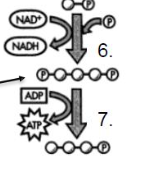
Step 8: 3-Phosphoglycerate → 2-Phosphoglycerate
What happens? The phosphate group is shifted to a new position.
Why? To prep the molecule for the final step.
Visual: Rearrangement.
Analogy: Like moving the engine in a car to the back before a race.
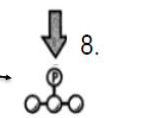
Step 9: 2-Phosphoglycerate → Phosphoenolpyruvate (PEP)
What happens? A water molecule is removed (dehydration).
Why? Makes the molecule even more unstable.
Visual: Water (H₂O) is released.
Analogy: Like squeezing water out of a sponge before lighting it on fire.
Step 9: 2-Phosphoglycerate → Phosphoenolpyruvate (PEP)
What happens? A water molecule is removed (dehydration).
Why? Makes the molecule even more unstable.
Visual: Water (H₂O) is released.
Analogy: Like squeezing water out of a sponge before lighting it on fire
Second atp payoff
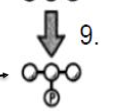
Step 10: PEP → Pyruvate
What happens? The last phosphate is removed and added to ADP → more ATP made.
Why? Final ATP payout.
Energy? 2 ATP made here (1 per G3P).
End Result? You get 2 pyruvate, ready for the next stage.
Analogy: Like launching the final piece of a firework show — boom, big payoff.
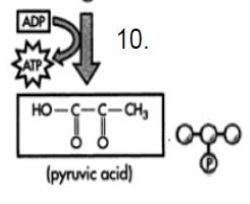
Glucose used
Used:1
Pyruvate used
2 Pyruvate
Atp used
2 Atp
ATP made
4 made
Net ATP
2 Net atp
NADH made
2 Nadh made
Water Released
2 water relased
Final Result of Glycolysis (What’s the point?)
You're breaking 1 glucose into 2 pyruvates to:
Make ATP = energy your cells need to live
Make NADH = energy storage for the next stage (like saving coins)
Prepare pyruvate for the Krebs Cycle or fermentation
What is the overall purpose of glycolysis?
To break 1 glucose into 2 pyruvate molecules, making 2 ATP (net) and 2 NADH in the process. It happens in the cytoplasm and does not require oxygen.
Q: What is phosphorylation in glycolysis?
It's when a phosphate group is added to a molecule. ATP gives its phosphate to glucose to make it more reactive
What happens during the investment phase of glycolysis?
2 ATP are used to add phosphates to glucose, turning it into fructose-1,6-bisphosphate.
Q: What is the end product of the investment phase?
Fructose 1,6-bisphosphate
What happens during the sugar-splitting phase of glycolysis?
Fructose 1,6-bisphosphate splits into 2 molecules: DHAP and G3P. DHAP is converted into another G3P.
The 6-carbon sugar fructose-1,6-bisphosphate is split into two 3-carbon sugars:
One is called G3P (glyceraldehyde-3-phosphate)
The other is called DHAP (dihydroxyacetone phosphate)
But only G3P can continue in glycolysis — so…
👉 DHAP gets converted into another G3P
So now you have 2 identical G3P molecules, and each one goes through the second half of glycolysis.
Q: What happens during the oxidation phase?
: Both G3P molecules are oxidized using NAD+, which becomes NADH. Phosphates are added to the sugars.
What’s substrate-level phosphorylation?
When a phosphate is directly transferred from a molecule to ADP, making ATP.
What happens during the payoff phase?
Phosphates are removed from the sugars and added to ADP to make 4 ATP (2 net), and 2 NADH are made.
What happens if there is no oxygen after glycolysis?
The cell goes into fermentation, turning pyruvate into either lactic acid or ethanol + CO₂, just to recycle NAD⁺.
What’s the difference between NAD⁺ and NADH?
NAD⁺ is an empty battery. NADH is charged up with electrons (like a full battery) and carries energy to the mitochondria.
Lactic Acid Fermentation
:
🧾 Where it happens:
In animal cells (like your muscles when you work out too hard)
Some bacteria (used in yogurt & sour cream)
🧬 What happens:
Pyruvate (from glycolysis) gets turned into lactic acid
NADH gives its electrons to pyruvate → becomes NAD⁺ again
🔄 Why?
So glycolysis can restart by reusing NAD⁺
⚡ No extra ATP is made here — just recycling
🤕 Effect:
Lactic acid builds up in muscles = soreness
Alcoholic Fermentation:
🧾 Where it happens:
In yeast and some plants
🧬 What happens:
Pyruvate → becomes ethanol (alcohol) and CO₂
NADH → gives electrons back → regenerates NAD⁺
🔄 Why?
Same reason: to keep glycolysis going when no O₂ is around
🍺 Effect:
This is how bread rises (CO₂ bubbles) and how alcohol is made
HOW TO IDENTIFY PHASE IN PICTURES:
ATP is used = Investment (Steps 1 & 3)
Sugar splits in 2 = Cleavage (Step 4)
ATP/NADH made = Payoff (Steps 6–10)
What is ATP? Why is it important? How is it recycled?
ATP (Adenosine Triphosphate) = the main energy currency in your cells
It powers muscles, thinking, breathing — everything.
🧠 Analogy: ATP = a charged battery.
When used, it becomes ADP (battery drained)
When recharged (by adding phosphate), it becomes ATP again
ATP is recycled by:
Breaking it: ATP → ADP + Pi (releases energy)
Rebuilding it: ADP + Pi → ATP (requires energy, like from food)
equation for cellular respiration.
✅ Balanced Equation:
C₆H₁₂O₆ + 6O₂ → 6CO₂ + 6H₂O + ~36-38 ATP
Glucose + Oxygen → Carbon Dioxide + Water + Energy
What are electron carriers? What role do they play? Name two.
Electron carriers are molecules that temporarily hold electrons taken from glucose.
They carry energy to the Electron Transport Chain (ETC)
Think of them like charged delivery trucks bringing energy
🧠 Analogy: NADH and FADH₂ are Uber Eats drivers, delivering electrons to the “power plant” (ETC) to make ATP
Two carriers:
NAD⁺ → NADH
FAD → FADH₂
What are Redox reactions?
Redox = Reduction + Oxidation
Oxidation = Losing electrons
Reduction = Gaining electrons
🧠 Analogy: Think of electrons like money:If you give away money (electrons) → you're oxidized
If you receive money (electrons) → you're reduced
Redox reactions are how energy is transferred in cellular respiration! Electrons carry energy — so transferring them powers ATP production.
Phase 1: Energy Investment Phase
🧠 Goal: Spend energy to prepare glucose for breaking
What happens:
2 ATP are used
Glucose gets phosphorylated (phosphates added to it)
Glucose is turned into Fructose 1,6-bisphosphate
That molecule is then split into two 3-carbon sugars:
DHAP and G3P
DHAP is converted into another G3P
✔ At the end of Phase 1:
You now have 2 G3P molecules
No energy is made yet — you actually lost 2 ATP
Phase 2: Energy Payoff Phase
🧠 Goal: Each G3P makes NADH + ATP as it becomes pyruvate
What happens for EACH G3P:
NAD⁺ takes electrons → NADH is made
2 ATP are made by substrate-level phosphorylation
Ends as Pyruvate (3C)
Since you had 2 G3P → this happens twice
✔ At the end of Phase 2 (total from both G3P):
2 Pyruvate
2 NADH
4 ATP (but subtract 2 used earlier) → net 2 AT